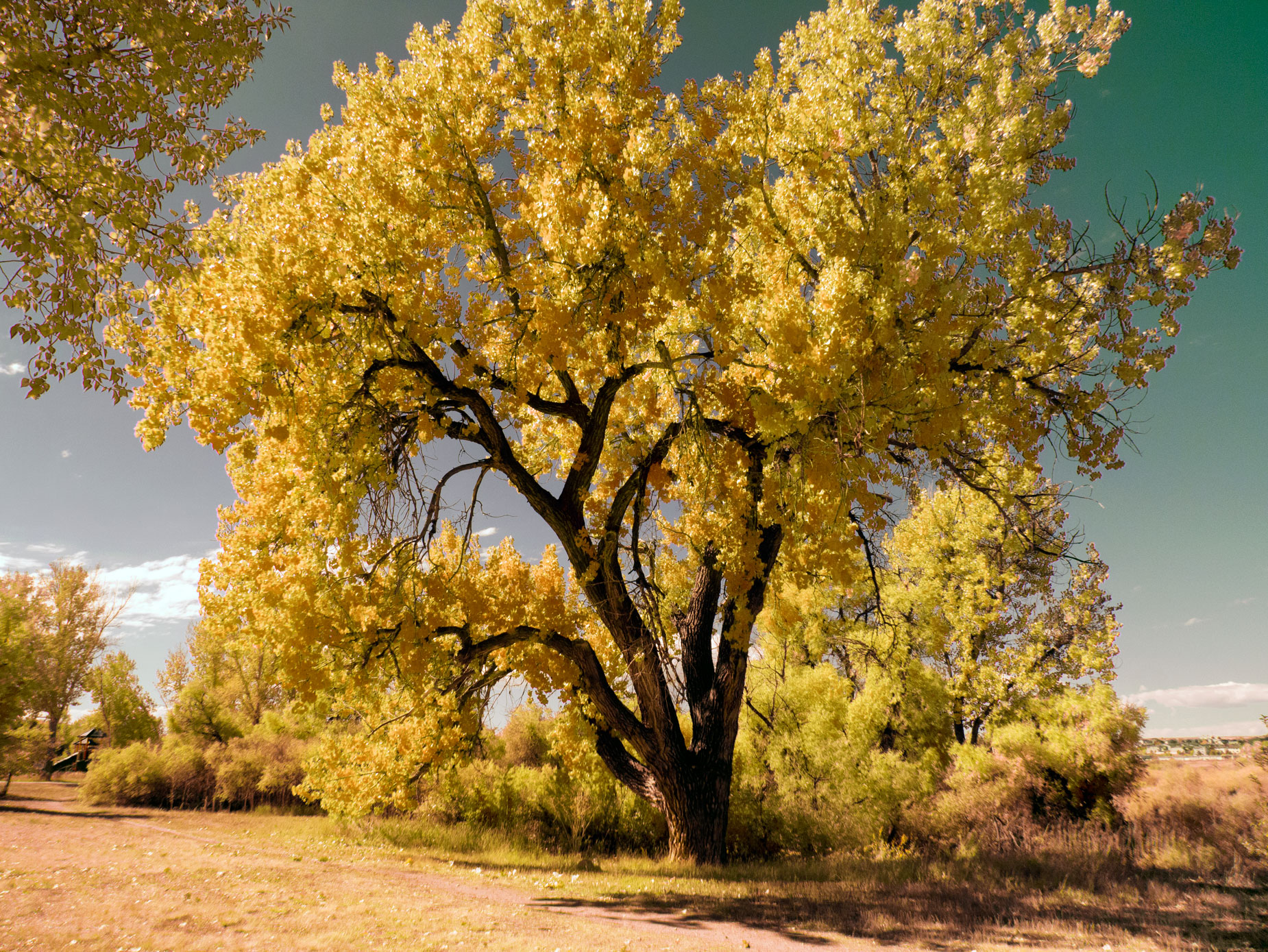Factoid: Shooting infrared images requires a different focusing technique because the wavelengths of infrared light are different enough that the refractive properties of a lens will bend it at different angles than it will for the wavelengths of visible light. This happens for much the same reason as when chromatic aberration—more on that subject later—occurs: When light passes through a lens element, different wavelengths of light bend at slightly different angles
Since IR light focuses at a different point than visible light, every lens you own may have a different focus shift and zoom lenses, as I was about to find out, can have an even more different shift depending on focal length. Nowadays some, but not all, manual focus lenses have a red mark on their barrel allowing you to adjust focus when photographing with infrared light. Here’s how it works: After focusing normally, the focusing ring has to be turned to that red mark. Some zoom lenses, certainly not the one mentioned in today’s post, have two IR marks, one at the wide end, the other at the narrower end of the focal length range.
For a long time my solution, as well as others, for infrared focusing challenges has been to shoot at smaller apertures and trust that hyperfocal focusing and depth-of-field will cover any discrepancy in how a specific lens focuses. Well my bothers and sisters, I’m here to tell you that these systems and methods only work until they don’t. That’s because, as I have recently discovered, there’s a lot more to infrared focusing than even after many years of practicing my craft, than I previously realized.
Here’s what I found what happened with one specific lens and you might want to use similar tests as outlined below if you’re not happy with the sharpness of the lenses used to make your own digital IR images.
Today’s Post by Joe Farace
If you keep feeling a point that has been sharpened, the point cannot long preserve its sharpness. — Lao Tzu
 During a recent infrared PhotoWalk in Downtown Parker, Colorado I did an impromptu and mostly unscientific lens test of the Lumix 12-32mm f/3.5-5.6 ASPH kit lens I was shooting. In that post I said, “My unofficial take on the lens is that it’s performance is, at best, marginal although the lens seems more than acceptably sharp at smaller apertures around f/11 and diffraction* didn’t seem to be a problem at that aperture.” But as I later found out that wasn’t the whole story.
During a recent infrared PhotoWalk in Downtown Parker, Colorado I did an impromptu and mostly unscientific lens test of the Lumix 12-32mm f/3.5-5.6 ASPH kit lens I was shooting. In that post I said, “My unofficial take on the lens is that it’s performance is, at best, marginal although the lens seems more than acceptably sharp at smaller apertures around f/11 and diffraction* didn’t seem to be a problem at that aperture.” But as I later found out that wasn’t the whole story.
Many of the images I made with that lens at a recent infrared PhotoWalk with my friend Barry Staver at Hudson Gardens—look for a pair of posts about this soon—could only charitably described a “somewhat sharp.” What was the problem? I thought that it could be one of several possibilities: It could be diffraction. I shot those questionable images at f/16, although the lens stops down to f/22. It could be camera movement. Or it could be that the performance of the lens at f/16 isn’t as good at it is compared to whatever the “sweet spot” for the lens really is. Since I couldn’t afford to replace it with a new 12-32mm lens or something similar, I decided to look all of these possibilities with a test shoot at McCabe Meadows.
How I Made this shot: This SOOC image of my favorite tree at right was made with a Manfrotto tripod-mounted Panasonic Lumix GX1 that had been converted by Life Pixel using their Hyper Color filter. The lens used was a Lumix 12-32mm f/3.5-5.6 ASPH kit lens at 12mm (24mm equivalent.) The exposure was 1/1250 sec at f/8 and ISO 400.
The Test & Results
My plan was to mount the Lumix GX1 on a tripod in front of my favorite tree and shoot it at different apertures to find the lens’s true sweet spot when used with an infrared converted camera. Tripod mounting should minimize the effect of hand holding, although all of the images that I made with my IR-converted (720nm) G5 during the Hudson Gardens PhotoWalk with an Olympus 17mm f/1.9 lens attached were tack sharp at f/16. I also planned to shoot the lens at both ends of its zoom range as well as someplace in the middle and here’s what I found:
- With the lens set at 12mm, the sweet spot for the Lumix 12-32mm f/3.5-5.6 ASPH kit lens was f/8 but f/5.6 was pretty close. At all other apertures the images ranged from barely acceptably sharp to somewhat soft.
- With the lens set at 32mm, its maximum aperture goes to f/5.6. All the images I made at this focal length were sharp all the way from wide open up to and including f/11.
- With the lens set around 20mm, the lens was sharp from wide open to f/11 but f/22 was soft. Even when shooting at 13mm the range of sharpness increases beyond what it does at the f/8 sweet spot at 12mm. showing that, with some zoom lenses, focal length is just as critical as aperture.

How I Made this Shot: This is what the RAW file (above right) looked like when it was processed using the Hyper Color to Super Color Photoshop action that was, at one time, included when you had your camera converted to infrared capture by Life Pixel. After push button processioning, I hit the file with a tiny amount of Vivenza to, you know, punch up the colors a bit.
So what have we learned today?
In the past, Image Resources tested this lens and I have the ultimate respect for them and their testing methodologies. They stated that, “The Panasonic 12-32mm shows impressive sharpness throughout the zoom range, even wide open.” All of that may be true when shooting using visible light. They also say that “While not completely devoid of chromatic aberration, the Panasonic 12-32mm does very well at controlling it.” Again, I think that may be true depending on how much you are offended by LOCA— Longitudinal Chromatic Aberration. This effect occurs when different wavelength of color focus at a different distance from the lens after passing through a lens and don’t converge at the same point. This can result in green or magenta fringing that’s almost impossible to eliminate in post production. At f/8, which was my best (sharpness) test results at 12mm, there is noticeable magenta fringing at higher magnifications that may be difficult to see at normal viewing distance. This may bother perfectionists. Me? Not so much..
It seems to me and that the way I’ll be using this lens for infrared photography in the future will be to shoot everything at f/8 and never, no never, shooting it at 12mm, since even shooting at 13mm improves sharpness. As an aside, I noticed that the manual focus Rokinon 12mm f/2 NCS CS lens is available (used) for a little over one hundred bucks. It doesn’t appear to have an infrared mark but it might let me scratch my 12mm itch without worrying about the aperture to shoot at. If you have any experience with this lens and would like to share it with me, drop me an email. And if you do, many thanks.
PS: I know that lenses can be calibrated by some infrared specialist, but zoom lenses can only be calibrated for maximum sharpness at a specific focal length, so there’s that. I don’t think I’m finished with this topic, so there’s more to come in the future.
*Using really small apertures can produce diffraction.—that your sharpness decreases at smaller and smaller apertures. As a lens is stopped down, lens aberration control improves; but the effects of diffraction increase. Diffraction is not a lens aberration or a manufacturing defect: It is an unavoidable consequence of the physics of light.
 I’ve found that Life Pixel does a great job with IR conversions and they’ve done most of the conversions for my Canon DSLRs and all of my Panasonic Lumix G-series cameras. This is not a paid or sponsored endorsement, just my experience.
I’ve found that Life Pixel does a great job with IR conversions and they’ve done most of the conversions for my Canon DSLRs and all of my Panasonic Lumix G-series cameras. This is not a paid or sponsored endorsement, just my experience.
Used copies of my book, The Complete Guide to Digital Infrared Photography are currently available new from Amazon for $33.66 or used copies for less than four bucks, as I write this. Creative Digital Monochrome Effects has a chapter on IR photography and new copies are available from Amazon for $16.16 with used copies starting at less than three bucks, which is a heckuva deal.